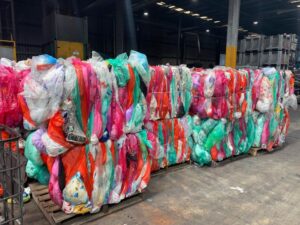The decision to scrap the levy on waste exports means more plastics will end up in landfill
Most plastic Australians use already ends up in landfill and the decision to scrap the levy on waste exports will only make things worse
The Commonwealth Government has announced that it will bow to industry lobbying and scrap a proposed $4 per tonne charge on the export of waste. The export levy was set to be imposed in the 2024-25 financial year, but has been removed from next Tuesday’s budget.
The levy was intended to stop companies from exporting Australia’s waste – most of which ends up in countries that are not equipped to recycle it – and to encourage the development of domestic recycling industries. The removal of the levy means that exporters will be allowed to continue to profit from selling Australia’s waste to other nations, where much of it will ultimately end up in landfills, beaches, and oceans.
Plastics were just one intended target of the levy. The 2022 collapse of REDcycle, which was Australia’s largest soft-plastics recycling scheme, showed the limits of Australia’s ability to recycle. For many years, Australia shipped its plastics waste overseas, but many of the nations that Australia once relied on to take it have now introduced laws that ban the importation of waste plastics. This includes China’s ‘National Sword’ policy, which was implemented in early 2018.
These bans resulted in an agreement between government and industry to achieve ambitious targets for the recycling and reuse of plastic waste by 2025, which were set out in the 2025 National Packaging Targets and the 2019 National Waste Action Plan. Yet recycling rates have stagnated, and little progress has been made on reducing the volume of plastic waste going to landfills. The removal of the levy on exports is a further step in the wrong direction.
Australia has consumed a total of 56.9 million tonnes of plastic since 2000 – this is equivalent to the weight of more than 1,000 Sydney Harbour Bridges. More than half of this – 31.9 million tonnes – has been disposed of, while just 5.8 million tonnes have been recovered through recycling, composting or energy recovery.
Only 14% of plastic waste generated in 2020–21 (the most recent year figures are available for) was recovered – this is a decline from a high of nearly 18% in 2008. Over a 20-year period the rate of recovery has, at best, remained stable, and at worst – as an Australian Government report states – is “even trending down”.
The Commonwealth’s decision to drop the waste export levy was informed by a consultation process, and the largest number of organisations to respond were from the plastic’s industry (closely followed by the tyre and paper and cardboard industries). Even they agreed that the levy had the “potential … to push the industry to onshore processing,” which was of course the point – if it was more expensive to export waste we might actually do something about it here at home. Australia should not shunt responsibility for its waste problem onto other countries.
But the bigger problem is that it is difficult to recycle plastics anywhere in the world. The reality is that the most effective way to solve our ever-growing waste problem is to drastically reduce the amount of waste produced and consumed in the first place.
Between the Lines Newsletter
The biggest stories and the best analysis from the team at the Australia Institute, delivered to your inbox every fortnight.
You might also like
Soft plastic recycling is back in supermarkets!
For many of us, the end of June will mark the return of soft plastic recycling run by the Soft Plastics Taskforce (SPT), which is made up of the three major supermarkets: Woolworths Group, Coles Group and ALDI. But this may be premature since the joint recycling strategy from the Ministry of the Environment and
The great gas rip off: how the government can stop us all getting burned
The Albanese government could soon intervene to start fixing one of the biggest ongoing public policy fiascos in this country’s history: Australia’s rampant, uncontrolled gas export industry.
I’ll admit it. Dutton is spot on about one thing when it comes to gas
It’s not often I agree with Peter Dutton, but I can admit when he’s right and he’s right about two things.



